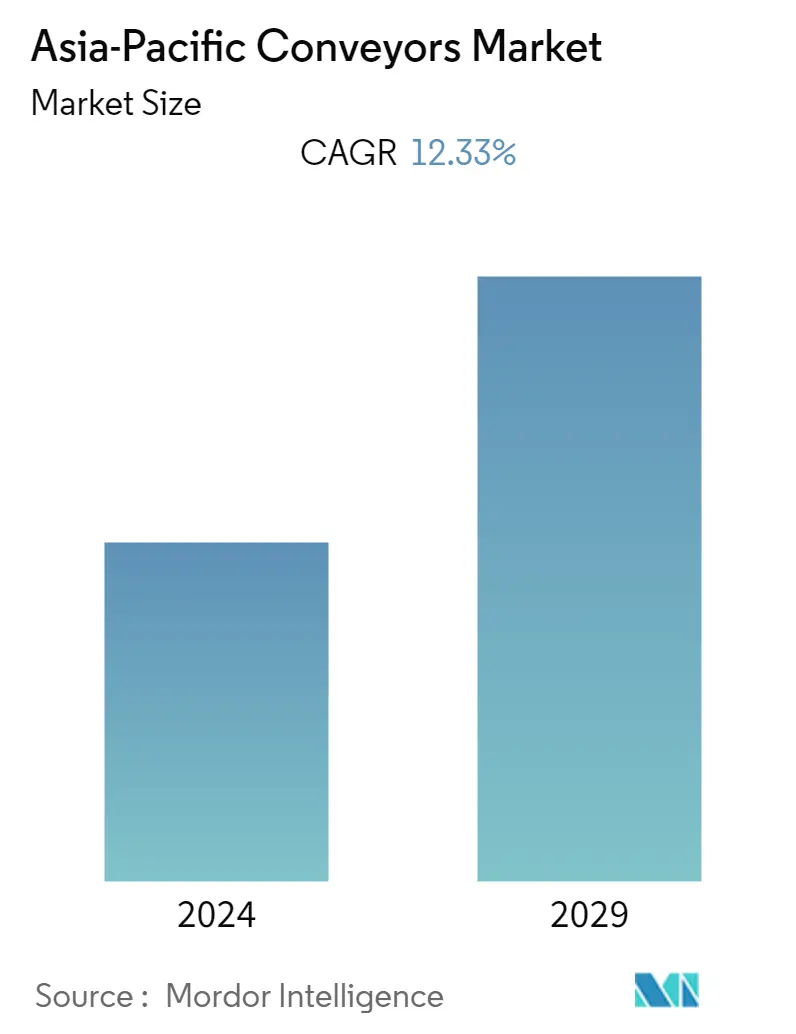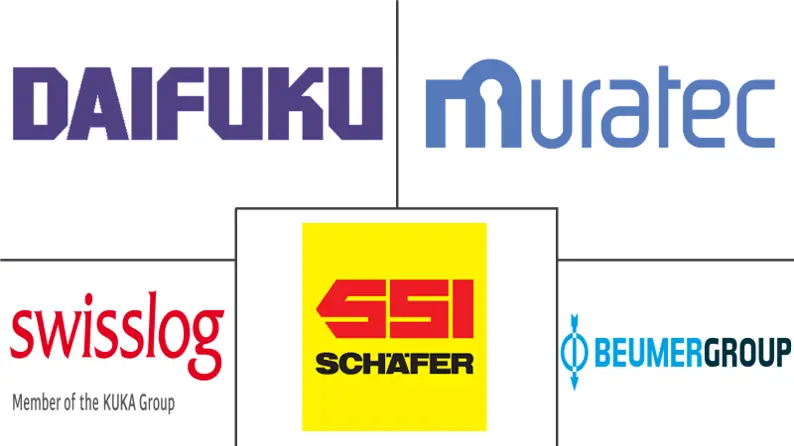Market Size of Asia-Pacific Conveyors Industry

| Study Period | 2019 - 2029 |
| Base Year For Estimation | 2023 |
| Forecast Data Period | 2024 - 2029 |
| Historical Data Period | 2019 - 2022 |
| CAGR | 12.33 % |
| Market Concentration | Medium |
Major Players
*Disclaimer: Major Players sorted in no particular order |
Asia Pacific Conveyors Market Analysis
The Asia-Pacific Conveyors Market is expected to register a CAGR of 12.33% over the forecast period from 2020 to 2025. Asia-Pacific has been a prominent contributor to the growth of conveyors globally. The growing demand for conveyors across industries such as manufacturing, automotive, and e-commerce boosts the market's development. Manufacturing is one of the significant pillars of Asia-Pacific's economy and is undergoing a rapid transformation. It is reported that low-end manufacturing firms are moving to Southeast Asia to cut costs, including automotive and electronics manufacturing companies, which is expected to increase conveyors' adoption.
- According to the NDRC (National Development and Reform Commission), China's investment in the manufacturing industry grew significantly in the first eight months of 2019. From January 2019 to August 2019, the investment increased by 12% year on year, quickening 0.9% points from that in the January-July period. As per the 13th Five-Year Plan of Smart Manufacturing, China aims to establish its automation systems and complete its transformation by 2025. An increasing number of companies are adopting conveyors in the region to reduce production costs and maintain a competitive advantage over western economies. Such instances are expected to positively impact the automation systems such as conveyors in the region.
- Natural resources and their procurement create market significant opportunities for conveyors in the region, which automate the process flow. The vast landscape offers new avenues for the logistics parties to introduce conveyors to ease materials' transition. The airport, post, and parcel, and warehouse segments have boosted the demand for conveyors and sortation systems. Additionally, the manufacturing industry has recorded an increase in demand for an automatic sortation system integrated across the conveyor belt, which reduces the error rate, thereby increasing the overall efficiency of the general warehouse logistic module, thus eradicating any associated supervision and loss.
- The region is witnessing significant merger and acquisition activities. For instance, in March 2019, Daifku completed the acquisition of Vega Conveyors and Automation Private Limited, a prominent material-handling vendor based in India. The acquisition is expected to strengthen the company's localization strategy. It is expected to benefit from the increasing demand for automation in the Asia-Pacific region. In December 2019, Habasit, a conveyor and processing belting solutions company, acquired Namil Belt Industrial Co., Ltd. and Korea Belt Services in South Korea. The acquisitions expand Habasit's level of service for consumers in the South Korean market. The company in Korea will continue to offer a broad range of Habasit conveyors, power transmission, and processing belts.
- The outbreak of COVID-19 is expected to influence industrial spending in the region significantly over a certain period, due to the non-operational status of multiple industries deemed non-essential by governments in the region are facing significant losses that are expected to influence their technology spending in automation systems such as conveyors, till the end of 2021. According to the 2020 Mastercard study, e-commerce is on the rise in the Asia Pacific, with 30% of people in Australia, 49% in India, 55% in China, and 34% in Japan planning to make more purchases online. Simultaneously, consumers think less in-store shopping is here to stay with 38% in Australia, 68% in India, 57% in China, and 40% in Japan. Such high activity of the e-commerce sector in the region is expected to increase the demand for efficient logistics and warehousing systems such as conveyors.
Asia Pacific Conveyors Industry Segmentation
Conveyor systems are mechanical devices or assemblies that are used to transport various materials with little effort. There are different kinds of conveyor systems, usually consisting of a frame that supports either wheels, rollers, or a belt, upon which the materials move from one place to another. The scope of the study is currently focused exclusively on the Asia-Pacific region.
| Product Type | |
| Belt | |
| Roller | |
| Pallet | |
| Overhead |
| End-User Industry | |
| Airport | |
| Retail | |
| Automotive | |
| Manufacturing | |
| Food and Beverage | |
| Pharmaceuticals | |
| Mining |
| Country | |
| Australia | |
| China | |
| India | |
| Japan | |
| Indonesia | |
| Malaysia | |
| Singapore | |
| South Korea | |
| Taiwan | |
| Thailand |
Asia-Pacific Conveyors Market Size Summary
The Asia-Pacific conveyor system market is experiencing robust growth, driven by the region's pivotal role in global manufacturing, automotive, and e-commerce sectors. The shift of low-end manufacturing to Southeast Asia, coupled with significant investments in automation, particularly in China, is propelling the adoption of conveyor systems. The region's vast landscape offers opportunities for logistics enhancements, with increased demand for conveyors in airports, warehouses, and parcel handling. The retail sector's transformation, fueled by e-commerce growth, is further boosting the need for efficient logistics solutions, including conveyors and sortation systems. This trend is supported by the rising middle-class population and changing consumer behaviors in countries like China, India, and Indonesia, making Asia-Pacific a significant hub for e-commerce and automated logistics.
The competitive landscape of the Asia-Pacific conveyor market is characterized by the presence of both domestic and international players, with companies like Daifuku Co. Ltd, BEUMER Group, and Murata Machinery Ltd. leading the charge. Strategic mergers and acquisitions, such as Daifuku's acquisition of Vega Conveyors and Habasit's expansion in South Korea, are enhancing market capabilities and service offerings. The Indian market, in particular, is poised for growth due to government initiatives like 'Make in India' and significant investments in infrastructure and logistics. The demand for conveyor systems is further bolstered by advancements in the mining and aviation sectors, with substantial investments aimed at optimizing processes and expanding capacity. Overall, the Asia-Pacific conveyor system market is set for continued expansion, driven by technological advancements, strategic investments, and the region's dynamic economic landscape.
Asia-Pacific Conveyors Market Size - Table of Contents
-
1. MARKET DYNAMICS
-
1.1 Market Overview
-
1.2 Market Drivers
-
1.2.1 Increased Usage of Automation Across the Manufacturing Industry
-
1.2.2 Rapid Growth of E-commerce
-
-
1.3 Market Restraints
-
1.3.1 High Initial Investments
-
-
1.4 Industry Value Chain Analysis
-
1.5 Industry Attractiveness - Porter's Five Forces Analysis
-
1.5.1 Bargaining Power of Suppliers
-
1.5.2 Bargaining Power of Buyers
-
1.5.3 Threat of New Entrants
-
1.5.4 Intensity of Competitive Rivalry
-
1.5.5 Threat of Substitutes
-
-
1.6 Assessment of the impact due to COVID-19
-
-
2. MARKET SEGMENTATION
-
2.1 Product Type
-
2.1.1 Belt
-
2.1.2 Roller
-
2.1.3 Pallet
-
2.1.4 Overhead
-
-
2.2 End-User Industry
-
2.2.1 Airport
-
2.2.2 Retail
-
2.2.3 Automotive
-
2.2.4 Manufacturing
-
2.2.5 Food and Beverage
-
2.2.6 Pharmaceuticals
-
2.2.7 Mining
-
-
2.3 Country
-
2.3.1 Australia
-
2.3.2 China
-
2.3.3 India
-
2.3.4 Japan
-
2.3.5 Indonesia
-
2.3.6 Malaysia
-
2.3.7 Singapore
-
2.3.8 South Korea
-
2.3.9 Taiwan
-
2.3.10 Thailand
-
-
Asia-Pacific Conveyors Market Size FAQs
What is the current Asia-Pacific Conveyors Market size?
The Asia-Pacific Conveyors Market is projected to register a CAGR of 12.33% during the forecast period (2024-2029)
Who are the key players in Asia-Pacific Conveyors Market?
Daifuku Co. Ltd, Murata Machinery, Ltd., SSI Schaefer AG , KUKA AG (Swisslog AG) and BEUMER Group are the major companies operating in the Asia-Pacific Conveyors Market.

